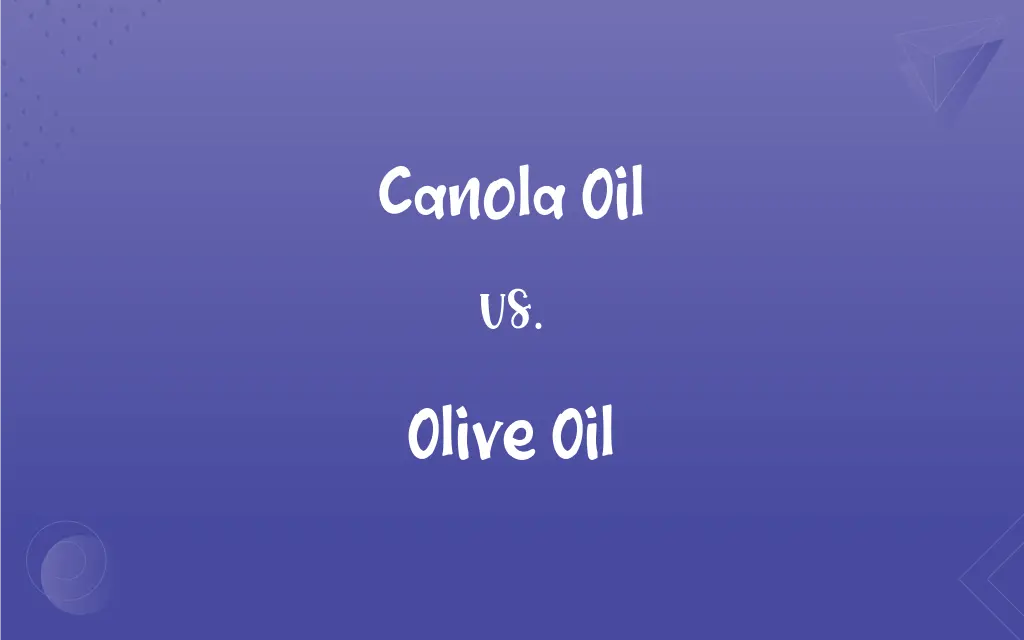Canola Oil vs. Olive Oil: What's the Difference?
Edited by Aimie Carlson || By Janet White || Published on January 31, 2024
Canola oil is a vegetable oil derived from rapeseed, known for its neutral flavor and high smoke point; olive oil is extracted from olives, valued for its distinct flavor and health benefits.

Key Differences
Canola oil is made from the seeds of the canola plant, a type of rapeseed, and is known for its light texture. Olive oil, on the other hand, is pressed from olives, the fruit of the olive tree, and is known for its rich, fruity flavor. Both oils are staples in cooking but come from very different plants.
Canola oil is lower in saturated fat and higher in omega-3 fatty acids, making it a heart-healthy option. Olive oil is rich in monounsaturated fats and antioxidants, known for its health benefits, including anti-inflammatory properties. Both oils contribute to a healthy diet in different ways.
Canola oil's neutral taste and high smoke point make it ideal for frying and baking. Olive oil is celebrated for its robust flavor, often used in salad dressings, marinades, and for finishing dishes. Both oils are versatile but used differently in cooking.
Canola oil, being low in saturated fat, is often recommended for heart health. Olive oil, particularly extra virgin olive oil, is associated with the Mediterranean diet and has been linked to numerous health benefits, including a lower risk of heart disease. Both oils offer unique health advantages.
The production of canola oil involves crushing canola seeds and extracting the oil, often using chemical solvents. Olive oil is extracted through pressing the olives, and the quality depends on the method of extraction. Both oils go through different processes to reach consumers.
ADVERTISEMENT
Comparison Chart
Source
Derived from canola plant seeds
Extracted from olives
Flavor
Neutral, light flavor
Distinct, fruity flavor
Smoke Point
High, suitable for high-heat cooking
Lower, varies with type
Nutritional Content
High in omega-3 fatty acids, low in saturated fat
Rich in monounsaturated fats, antioxidants
Best Culinary Use
Frying, baking
Dressings, finishing dishes
ADVERTISEMENT
Canola Oil and Olive Oil Definitions
Canola Oil
Canola oil is derived from rapeseed.
Canola oil's production involves refining rapeseed oil.
Olive Oil
Olive oil is a key component of the Mediterranean diet.
Incorporating olive oil into my meals has been great for my health.
Canola Oil
Canola oil is commonly used in cooking.
Canola oil is my go-to for baking because of its neutral flavor.
Olive Oil
Olive oil is popular in dressings and marinades.
I use olive oil for its rich flavor in my homemade dressings.
Canola Oil
Canola oil is known for its heart-health benefits.
I switched to canola oil to reduce my saturated fat intake.
Olive Oil
Olive oil is extracted from olives.
I love drizzling olive oil on my salads for an extra kick of flavor.
Canola Oil
Canola oil is a type of vegetable oil.
I use canola oil for deep frying because of its high smoke point.
Olive Oil
Olive oil is valued for its health benefits.
Olive oil's antioxidants are a big part of my balanced diet.
Canola Oil
Canola oil has a light, neutral taste.
Canola oil is perfect for dishes where I don't want the oil flavor to dominate.
Olive Oil
Olive oil comes in various grades like extra virgin.
For cooking, I prefer extra virgin olive oil for its quality and taste.
FAQs
What is canola oil made from?
Canola oil is made from the seeds of the canola plant.
Is canola oil healthier than olive oil?
Both have health benefits, but olive oil is richer in antioxidants.
Does olive oil have a strong flavor?
Yes, it's known for its distinct taste.
Can canola oil be used in salads?
While possible, its neutral flavor is less preferred than olive oil.
Is canola oil good for frying?
Yes, its high smoke point makes it suitable for frying.
What's the best use for canola oil?
It's great for baking and high-heat cooking.
Is canola oil processed?
Yes, it often involves chemical processing.
What is olive oil made from?
Olive oil is made from pressed olives.
Can olive oil be used for frying?
It can, but its lower smoke point may affect flavor and nutrition.
What's the best use for olive oil?
Ideal for dressings, marinades, and finishing dishes.
What types of olive oil are there?
Common types include extra virgin, virgin, and refined olive oil.
Does olive oil have a low smoke point?
The smoke point varies, but extra virgin olive oil has a lower smoke point.
Is olive oil good for skin?
Yes, it's often used in skincare for its moisturizing properties.
Is olive oil part of a healthy diet?
Yes, especially in a Mediterranean diet.
Does canola oil contain omega-3s?
Yes, it's a good source of omega-3 fatty acids.
Can canola oil affect food flavor?
Its neutral taste has little impact on food flavor.
What are the health benefits of olive oil?
It's beneficial for heart health, anti-inflammatory, and rich in healthy fats.
How is olive oil extracted?
Typically through mechanical pressing.
Is canola oil vegan?
Yes, it's plant-based.
Can canola oil be used in cold dishes?
Yes, though other oils may be preferred for flavor.
About Author
Written by
Janet WhiteJanet White has been an esteemed writer and blogger for Difference Wiki. Holding a Master's degree in Science and Medical Journalism from the prestigious Boston University, she has consistently demonstrated her expertise and passion for her field. When she's not immersed in her work, Janet relishes her time exercising, delving into a good book, and cherishing moments with friends and family.
Edited by
Aimie CarlsonAimie Carlson, holding a master's degree in English literature, is a fervent English language enthusiast. She lends her writing talents to Difference Wiki, a prominent website that specializes in comparisons, offering readers insightful analyses that both captivate and inform.







































































